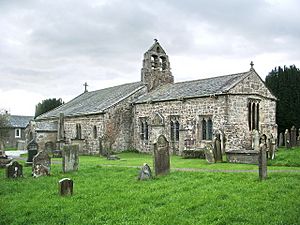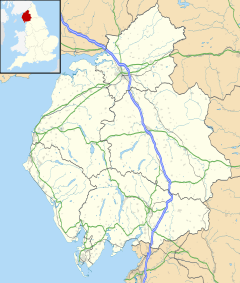Dean, Cumbria facts for kids
Quick facts for kids Dean |
|
|---|---|
 St. Oswald's Church, Dean |
|
| Population | 1,227 (2011) |
| OS grid reference | NY0749225226 |
| Civil parish |
|
| Unitary authority |
|
| Ceremonial county | |
| Region | |
| Country | England |
| Sovereign state | United Kingdom |
| Post town | Workington |
| Postcode district | CA14 |
| Dialling code | 01946 |
| Police | Cumbria |
| Fire | Cumbria |
| Ambulance | North West |
| EU Parliament | North West England |
| UK Parliament |
|
Dean is a small village and civil parish in Cumbria, England. It has a Church of England school and a historic church called St Oswald's. The nearby towns are Workington and Cockermouth.
Contents
Where is Dean?
Dean is located in Allerdale, which is in the west of Cumbria. This area is part of the North West of England. The village is about 7 kilometers (about 4.3 miles) southwest of Cockermouth. It sits on a smaller road just off the main A5086. Dean is also quite close to the Lake District National Park, being only about 3 kilometers (about 1.8 miles) west of its edge.
Life in Dean Village
Dean is home to The Royal Yew Inn, which is a traditional country pub. The village also has the Dean Church of England Primary School. This school welcomes children from Dean and three other small villages nearby.
Dean is surrounded by good farmland. The village has been around for a very long time. Records show it dates back to the 12th century, thanks to its old church. A grammar school was also started here in 1596. In the 1800s, farmers in Dean grew crops like wheat, oats, and potatoes. The Curwen family from Workington were the main landowners in this area for many years.
How Dean is Governed
Dean is part of the Copeland area for the UK Parliament. This means people in Dean vote for a Member of Parliament (MP) to represent them in the government. The current MP for this area is Trudy Harrison.
For local matters, Dean is part of the Cumberland unitary authority area. A unitary authority is a type of local government that handles most public services in its area.
Dean also has its own local council called the Dean Parish Council. This council helps manage things like local parks and community events. It also looks after the nearby villages of Branthwaite, Deanscales, Eaglesfield, Pardshaw, and Ullock.
St Oswald's Church
St Oswald's Church is a very old building on the edge of Dean village. It was first built in the 12th century. Later, a chancel (the part of the church where the altar is) was added in the 15th century. A sanctuary was built in the 17th century. Between 1967 and 1973, the church was greatly improved. New oak pews (church benches) and a pulpit (a raised stand for speaking) were put in.
The church has some special features. These include a Norman font (a basin for baptisms) and 15th-century windows in the chancel. St Oswald's Church is one of only three churches in Cumbria to have gargoyles (carved stone figures that often act as waterspouts). In the churchyard, you can see several old gravestones. There is also a Preaching Cross. The base of this cross is from the 12th century or even earlier. People think monks from Calder Abbey might have used it for preaching. The church is made from blocks of calciferous sandstone and has green slate roofs.
What's in a Name?
The name 'Dean' comes from an old English word, 'denu'. This word means 'valley'. So, Dean is essentially 'the village in the valley'.
Dean's History
Records show how many houses and people were in Dean over the years. In 1961, there were 710 people living in 214 houses. These records go all the way back to 1831. The number of people in the village changed between 500 and 700 from 1931 to 1961. The highest population was between 1821 and 1881.
The number of houses in Dean has usually been around 200. This number has changed a bit over time. For example, about 30 houses were lost between 1901 and 1931. However, the number of homes in Dean has now grown to 214.
Dean's Weather
The weather in Dean is typical for the north-west of England. This area often gets a lot of rain because it has high ground. However, Dean tends to be drier than the areas around it. It gets less than 800mm (about 31 inches) of rain each year. This is because of something called the rain shadow effect. The high ground of North Wales and the Lake District block some of the rain clouds.
The coldest months in Dean are usually January and February. July is typically the warmest month. The North West of England is quite exposed to strong winds. This is because it is close to the North Atlantic Ocean and has large upland areas. The strongest winds usually happen in the winter, especially from December to February.


